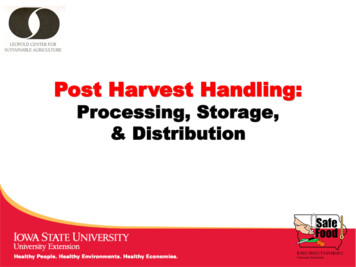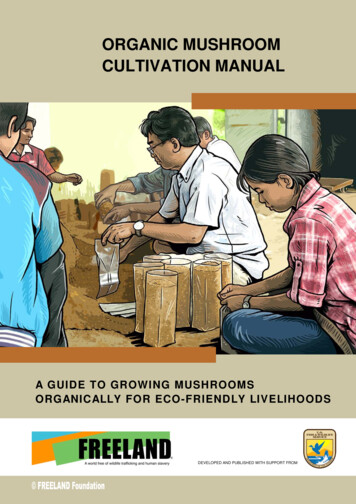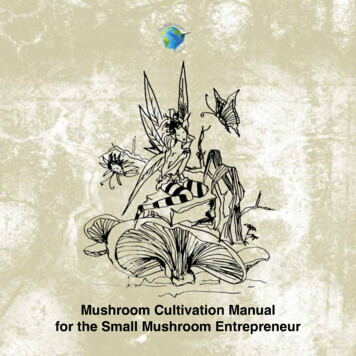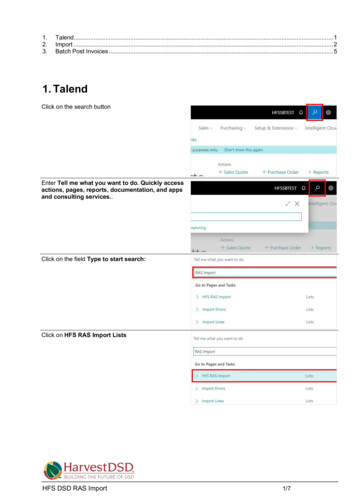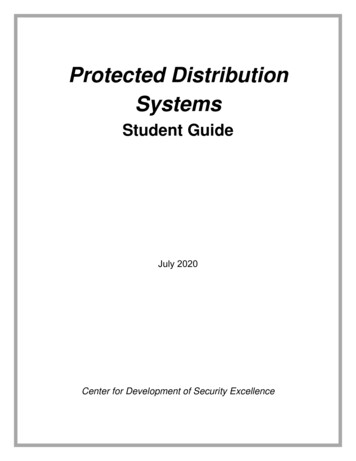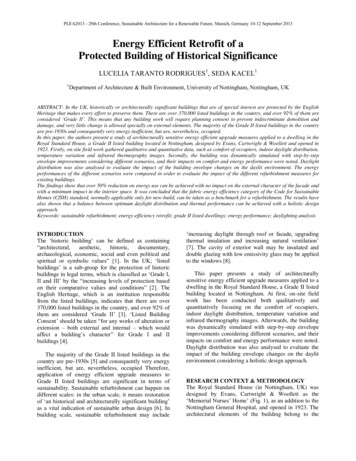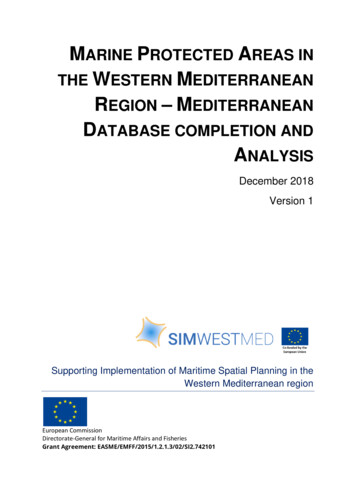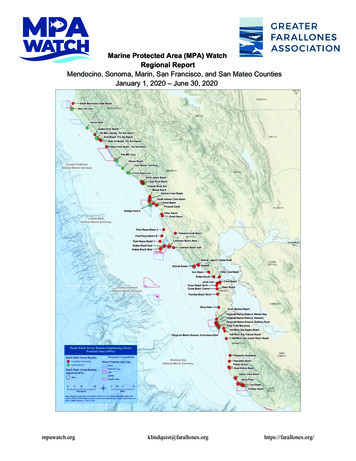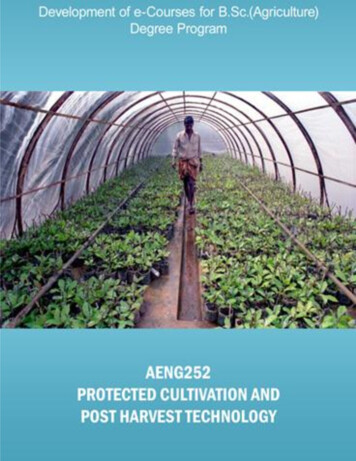
Transcription
Protected Cultivation & Post Harvest TechnologyCourse Developed ByTNAU
IndexL.N.1234567891213141516171819Lecture nameGreen houseGreenhouse structures of various typesPlant response to greenhouse environmentsEquipment required for controlling green houseenvironmentPlanning of green house facilityMaterials for construction of green housesDesign criteria and constructional details ofgreenhousesGreenhouse heating and distribution systemsIrrigation system used in greenhousesThreshing –threshers for different crops, parts,terminology, care and maintenanceWinnowing – manual and power operatedwinnowers, care and maintenanceGroundnut decorticator-hand operated and poweroperated decorticators, principles of working, careand maintenanceSheller – maize and castor ShellerDrying – grain drying, types of drying, types ofdryers, importance of dryingStorage- grain storage – types of storage structuresFruits and vegetables cleaning – machinery forcleaning fruits and vegetables, care andmaintenanceGrading – methods of grading, equipments forgrading of fruits and vegetables, care andmaintenancePage 0-5253-5455-5859-6869-7475-7980-88
20212223Size reduction – equipment for size reduction, careand maintenanceEvaporation – principles, types of evaporatorsFood standards and regulationsReference89-99100-106107-113113-119
Protected Cultivation & Post Harvest Technology1Lecture No.1Greenhouse is the most practical method of achieving the objectives of protectedagriculture, where the natural environment is modified by using sound engineering principles toachieve optimum plant growth and yields.Green House:A greenhouse is a framed or an inflated structure covered with a transparent ortranslucent material in which crops could be grown under the conditions of at least partiallycontrolled environment and which is large enough to permit persons to work within it to carryout cultural operations.The growing of off - season cucumbers under transparent stone for Emperor Tiberius inthe1stcentury,istheearliestreported protected agriculture. Thetechnologywasrarely employedduring the next 1500 years.In the16th century, glass lanterns, bell jarsand hot beds covered with glass wereused to protect horticultural cropsagainst cold. In the 17 th century, lowportable wooden frames covered withan oiled translucent paper were usedto warm the plant environment.In Japan, primitive methods using oil -paper and straw mats to protect crops from thesevere natural environment were used as long ago the early 1960s. Greenhouses in France andEngland during the same century were heated by manure and covered with glass panes. The firstgreenhouse in the 1700s used glass on one side only as a sloping roof. Later in the century, glasswas used on both sides. Glasshouses were used for fruit crops such as melons, grapes, peachesand strawberries, and rarely for vegetable production.Protected agriculture was fully established with the introduction of polyethylene after theWorld war II. The first use of polyethylene as a greenhouse cover was in 1948, when professorEmery Myers Emmert, at the University of Kentucky, used the less expensive material in placeof more expensive glass.The total area of glasshouses in the world (1987) was estimated to be 30,000 ha and mostof these were found in North- Western Europe. In contrast to glasshouses, more than half of theworld area of plastic green houses is in Asia, in which China has the largest area. According to1999 estimates, an area of 6, 82,050 ha were under plastic greenhouses (Table 1.1). In most ofthe countries, green houses are made of plastic and glass; the majority is plastic.Glasshouses and rigid plastic houses are longer-life structures, and therefore are mostlocated in cold regions where these structures can be used throughout the year. In Japan, year-5www.AgriMoon.Com
Protected Cultivation & Post Harvest Technology2round use of greenhouses is becoming predominant, but in moderate and warm climate regions,they are still provisional and are only used in winter.In India, the cultivation in the plastic greenhouses is of recent origin. As per 1994-95estimates, approximately 100 ha of India are under greenhouse cultivation.Since 1960, the greenhouse has evolved into more than a plant protector. It is now betterunderstood as a system of controlled environment agriculture (CEA), with precise control of airand root temperature, water, humidity, plant nutrition, carbon dioxide and light. The greenhousesof today can be considered as plant or vegetable factories. Almost every aspect of the productionsystem is automated, with the artificial environment and growing system under nearly totalcomputer control.Greenhouse EffectIn general, the percentage of carbon dioxide in the atmosphere is 0.035% (345 ppm). But, due tothe emission of pollutants and exhaust gases into the atmosphere, the percentage of carbondioxide increases which forms a blanket in the outer atmosphere. This causes the entrapping ofthe reflected solar radiation from the earth surface. Due to this, the atmospheric temperatureincreases, causing global warming, melting ofice caps and rise in the ocean levels whichresult in the submergence of coastal lines. Thisphenomenonof increase inthe ambienttemperature, due to the formation of the blanketof carbon dioxide is known as greenhouseeffect.The greenhouse covering material acts in asimilar way, as it is transparent to shorterwave radiation and opaque to long wave radiation.During the daytime, the shorter wave radiation enters into the greenhouse and getsreflected from the ground surface. This reflected radiation becomes long wave radiation and isentrapped inside the greenhouse by the covering material. This causes the increase in thegreenhouse temperature. It is desirable effect from point of view of crop growth in the coldregions.Advantages of GreenhousesThe following are the different advantages of using the green house for growing crops undercontrolled environment:1. Throughout the year four to five crops can be grown in a green house due to availability ofrequired plant environmental conditions.2.The productivity of the crop is increased considerably.3. Superior quality produce can be obtained as they are grown under suitably controlledenvironment.4. Gadgets for efficient use of various inputs like water, fertilizers, seeds and plantprotection chemicals can be well maintained6in a green house.5. Effective control of pests and diseases is possible as the growing area is enclosed.www.AgriMoon.Com
Protected Cultivation & Post Harvest Technology36. Percentage of germination of seeds is high in greenhouses.7. The acclimatization of plantlets of tissue culture technique can be carried out in a greenhouse.8. Agricultural and horticultural crop production schedules can be planned to takeadvantage of the market needs.9. Different types of growing medium like peat mass, vermiculate, rice hulls and compost thatare used in intensive agriculture can be effectively utilized in the greenhouse.10. Export quality produce of international standards can be produced in a green house.11. When the crops are not grown, drying and related operations of the harvested produce canbe taken up utilizing the entrapped heat.12. Greenhouses are suitable for automation of irrigation, application of other inputs andenvironmental controls by using computers and artificial intelligence techniques.13. Self-employment for educated youth7www.AgriMoon.Com
Protected Cultivation & Post Harvest Technology1Lecture No.2Greenhouse structures of various types are used successfully for crop production. Although thereare advantages in each type for a particular application, in general there is no single typegreenhouse, which can be considered as the best. Different types of greenhouses are designed tomeet the specific needs.2.1 Greenhouse type based on shapeGreenhouses can be classified based on their shape or style.For the purpose ofclassification, the uniqueness of the cross section of the greenhouses can be considered as afactor.As the longitudinal section tend to be approximately the same for all types, thelongitudinal section of the greenhouse cannot be used for classification. The cross sections depictthe width and height of the structure and the length is perpendicular to the plane of cross section.Also, the cross section provides information on the overall shape of the structural members, suchas truss or hoop, which will be repeated on every day.The commonly followed types of greenhouse based on shape are lean-to, even span,uneven span, ridge and furrow, saw tooth and quonset.2.1.1 Lean-to type greenhouseA lean-to design is used when a greenhouse is placed against the side of an existingbuilding. It is built against a building, using the existing structure for one or more of its sides(Fig.1). It is usually attached to a house, but may be attached to other buildings. The roof of thebuilding is extended with appropriate greenhouse coveringmaterial and the area is properly enclosed. It is typicallyfacing south side. The lean-to type greenhouse is limited tosingle or double-row plant benches with a total width of 7to 12 feet. It can be as long as the building it is attached to.It should face the best direction for adequate sun exposure.The advantage of the lean-to type greenhouse isthat, it usually is close to available electricity, water, andheat. It is a least expensive structure. This design makesthe best use of sunlight and minimizes the requirement ofroof supports. It has the following disadvantages: limitedspace, limited light, limited ventilation and temperaturecontrol. The height of the supporting wall limits the potential size of the design. Temperaturecontrol is more difficult because the wall that the greenhouse is built on, may collect the sun'sheat while the translucent cover of the greenhouse may lose heat rapidly. It is a half greenhouse,split along the peak of the roof.8www.AgriMoon.Com
Protected Cultivation & Post Harvest Technology22.1.2 Even span type greenhouseThe even-span is the standard type and full-size structure, the two roof slopes are of equal pitchand width (Fig.1). This design is used for the greenhouse of small size, and it is constructed onlevel ground. It is attached to a house at one gable end. It can accommodate 2 or 3 rows of plantbenches. The cost of an even-span greenhouse is more than the cost of a lean-to type, but it hasgreater flexibility in design and provides for more plants. Because of its size and greater amountof exposed glass area, the even-span will cost more to heat. The design has a better shape than alean-to type for air circulation to maintain uniform temperatures during the winter heatingseason. A separate heating system is necessary unless the structure is very close to a heatedbuilding. It will house 2 side benches, 2 walks, and a wide center bench. Several single andmultiple span types are available for use in various regions of India. For single span type thespan in general, varies from 5 to 9 m, whereas the length is around 24 m. The height varies from2.5 to 4.3 m.2.1.3 Uneven span type greenhouseThis type of greenhouse is constructed on hilly terrain. The roofs are of unequal width; make thestructure adaptable to the side slopes of hill (Fig. 2). This type of greenhouses is seldom usednow-a-days as it is not adaptable for automation.2.1.4 Ridge and furrow type greenhouseDesigns of this type use two or more A-frame greenhouses connected to one another along thelength of the eave (Fig. 2). The eave serves as furrow or gutter tocarry rain and melted snow away. The side wall is eliminatedbetween the greenhouses, which results in a structure with educes labour, lowers the cost of automation, improvespersonal management and reduces fuel consumption as there isless exposed wall area through which heat escapes. The snowloads must be taken into the framespecifications of these greenhouses since the snow cannot slideoff the roofs as in case of individual free standing greenhouses,but melts away. In spite of snow loads, ridge and furrow greenhouses are effectively used innorthern countries of Europe and in Canada and are wellsuited to the Indian conditions.2.1.5 Saw tooth type GreenhouseThese are also similar to ridge and furrow type greenhouses exceptthat, there is provision for natural ventilation in this type. Specificnatural ventilation flow path (Fig. 3) develops in asaw- tooth type greenhouse.9www.AgriMoon.Com
Protected Cultivation & Post Harvest Technology32.1.6 Quonset greenhouseThis is a greenhouse, where the pipe arches or trusses are supported by pipe purlingrunning along the length of the greenhouse (Fig 3). In general, the covering material used for thistype of greenhouses is polyethylene. Such greenhouses are typically less expensive than thegutter connected greenhouses and are useful when a small isolated cultural area is required.These houses are connected either in free, standing style or arranged in an interlocking ridge andfurrow.In the interlocking type, truss members overlap sufficiently to allow a bed of plants togrow between the overlapping portions of adjacent houses. A single large cultural space thusexists for a set of houses in this type, an arrangement that is better adapted to the automation andmovement of labour.2.2 Greenhouse type based on utilityClassification of greenhouses can be made depending on the functions or utilities. Of thedifferent utilities, artificial cooling and heating of the greenhouse are more expensive andelaborate. Hence based on the artificial cooling and heating, greenhouses are classified as greenhouses for active heating and active cooling system.2.2.1 Greenhouses for active heatingDuring the night time, air temperature inside greenhouse decreases. To avoid the coldbite to plants due to freezing, some amount of heat has to be supplied. The requirem
19 Grading – methods of grading, equipments for grading of fruits and vegetables, care and maintenance 80-88 . 20 Size reduction – equipment for size reduction, care and maintenance 89-99 21 Evaporation – principles, types of evaporators 100-106 22 Food standards and regulations 107-113 23 .
